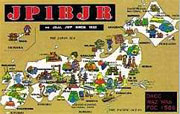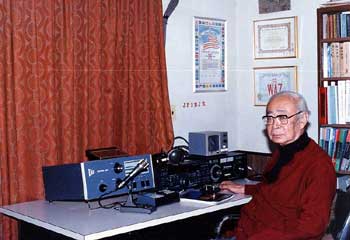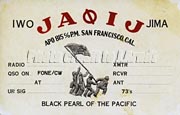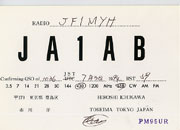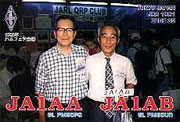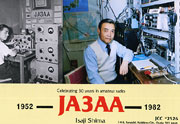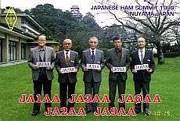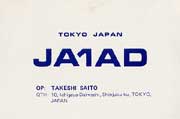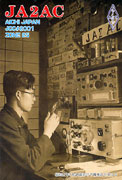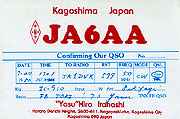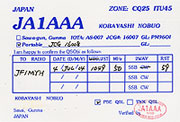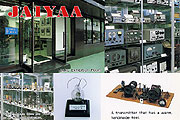An Outline History of
|
|
WW2 ended in August 1945. In September of the same year, the ban on HF listening was lifted. During March of 1946, hearings were conducted by the Japanese Government in regard to reopening amateur radio. Mr Okochi J2JJ represented the Hams during the hearing, but the end result, was that the Japanese Government took the position that the decision was not theirs to make at that time and should be referred to the proper authorities in GHQ in the form of a petition. And it was then that JARL requested a hearing with GHQ. It was granted and on March 28 1946, with Mr. Yagi as chairperson and with Mr.Okochi, they received a response from the GHQ duty officer. The response was not as was hoped for. Apparently the duty officer did not understand and misconstrued the hearing as being in regard to interference being made for US occupation forces HAMs. After the initial excitement, the mistake was discovered and the course was set for further discussion. After discussions were made, it soon became apparent that the resumption of Ham radio in Japan was once more a possibility and a sense of hopefulness prevailed. Yet this result was bitter sweet in the sense that there was no time table and the time of resumption was not clear, therefore issues still remained.
At that time, there were already numerous American military personnel using Ham radio... their prefixes until 1950 consisted of J + area number + 3 letters, ie.(J2AAA). After 1950 they used the JA prefix as determined by the ITU, which now became JA + area number + 2 letters, such as JA2HQ. Japanese Hams used 2 letter sufixes as well as 3 letter suffixes, as still found in Japan. Some Japanese Hams were disapointed when the ITU used JA instead of just J as was originally used. It needs to be borne in mind that I am relating much of which follows from my senior and mentor ... Mr. Himuro (JA2RM), who shared this information. Mr. Himuro stated the following : " Originally I was a SWL and enjoyed listening to the myriad of signals available on the HF band. Therfore, I was stopped in my tracks when I happened on my first experience with HAM radio to come across the 14 Mc amateur band with a signal so strong that it very nearly bowled me over. Of course at that time, I really did not understand the frequencies.... all I knew was that it was below 15 Mc. I also did not understand English very well, and when I heard JA2HQ... it sounded to me as "Jige-bow-to-headquwaler" so I thought it must be Communications of Regimental Headquarters on Tsukishima or Regan-Jima in Tokyo Bay. I often heard JA2HQ in QSO with HL9KQ since they seemed to have a regular sched.... sometimes other stations would call in breaker and I could hear other DX stations.
About a half month later, I was even more surprised to hear an even louder signal on my simple receiver.... so loud I thought it should melt my 1-V-1 receiving tube... it was JA2HP making QSO's with GI's in all parts of Japan !! Also JA2HP sounded to me as (Jig Able Two High Power) as it seemed like very high power indeed ! So in the end, I was finally able to understand that the JA's with their numbers represented different areas of Japan and as such, JA4 was Shikoku, JA5 as Kyushu, JA9 as Okinawa, JA7 as Hokkaido and Iwo-Jima as JA0IJ and JA0JI. The above system was that, which was authorized by GHQ during the Occupation of Japan period in history. " Jun 1st 1950 ; A new Radio law came into effect. Jun 26th 1951 ; The first Amateur HAM Radio examination was held with a total of 106 applicants. Mar 11th 1952 ; GHQ dissolved the "Memorandum of HAM Radio prohibition". Jul 29th 1952 ; Preliminary licenses were issued to 30 Japanese recipients. JA1AB, Mr. Hiroshi Ichikawa, was the first Ham to be licensed in Japan following WW2. The following is a short narrative from him in regard to that experience. He was soon followed a few weeks later by five other applicants. It is of interest here to note Mr.Ichikawa's recounting his feelings at that particular time. " Of course I was very excited to finally be able to go on the air as a Ham operater and when I finally succeeded in meeting MOST of the final requirements,but not the final, final requirement, I could no longer contain myself and I went up on the air and transmitted... Banzai... Banzai... Banzai... for all the world to hear. Of course this was illegal and when I was more settled, I realized that, that action was very very poor on my part... but at the time it was a feeling that I shall never forget.... later when I finally met with the officer for my final certification... it seemed to me he had a slight smile on his face... did he hear me that day ?... I will never know.... but at last... I WAS a Ham !!!!! "
During August of 1948, five more hams became licensed...JA1AA, AF, AH, AJ and JA3AA. However, these five were all licensed before WW2 and only Mr.Ichikawa was not. Before WW2, JA1AA was J2IB, JA1AC-J2MI, JA1AD-J2PU and JA1AE-J2KM.....
During the same month, mobile operation was allowed on the bands, provided that RX and TX was all-in-one and that power output could not exceed 50 watts.
The Ham population enjoyed an increase and peeked in 1994 to 1,300,000 and then entered a gradual decline, so that now it is around 500,000 in 2008. Of course, Japan is no exception. It would seem that the internet and cell phones have caught the attention of the younger generation. Needless to say, this decline is also reflected in JARL membership. (190,000 in 1994 -> 76,000 in 2008) |
| I would like to give credit at this time to my senior and mentor, JA2RM Mr.K.Himuro for his providing some of the background material contained herein, as well as information provided by the June issue 1996 of Japan's, CQ HAM radio magazine ........ |
